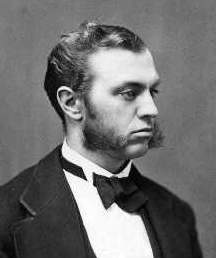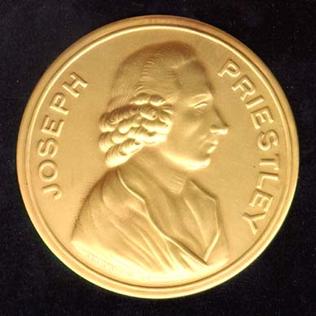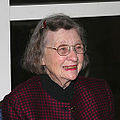
Ira Remsen was a chemist who, along with Constantin Fahlberg, discovered the artificial sweetener saccharin. He was the second president of Johns Hopkins University.

The American Chemical Society (ACS) is a scientific society based in the United States that supports scientific inquiry in the field of chemistry. Founded in 1876 at New York University, the ACS currently has nearly 157,000 members at all degree levels and in all fields of chemistry, chemical engineering, and related fields. It is the world's largest scientific society by membership. The ACS is a 501(c)(3) non-profit organization and holds a congressional charter under Title 36 of the United States Code. Its headquarters are located in Washington, D.C., and it has a large concentration of staff in Columbus, Ohio.

Eugene Eli Garfield was an American linguist and businessman, one of the founders of bibliometrics and scientometrics. He helped to create Current Contents, Science Citation Index (SCI), Journal Citation Reports, and Index Chemicus, among others, and founded the magazine The Scientist.

The Priestley Medal is the highest honor conferred by the American Chemical Society (ACS) and is awarded for distinguished service in the field of chemistry. Established in 1922, the award is named after Joseph Priestley, the discoverer of oxygen who immigrated to the United States of America in 1794. The ACS formed in 1876, spearheaded by a group of chemists who had met two years previously in Priestley's home.

Richard Neil Zare is the Marguerite Blake Wilbur Professor in Natural Science and a Professor of Chemistry at Stanford University. Throughout his career, Zare has made a considerable impact in physical chemistry and analytical chemistry, particularly through the development of laser-induced fluorescence (LIF) and the study of chemical reactions at the molecular and nanoscale level. LIF is an extremely sensitive technique with applications ranging from analytical chemistry and molecular biology to astrophysics. One of its applications was the sequencing of the human genome.

A Fleaker is a brand of container for liquids used in the laboratory. It can be described as a cross between the Griffin beaker and the Erlenmeyer flask.

Mary Lowe Good was an American inorganic chemist who worked academically, in industrial research and in government. Good contributed to the understanding of catalysts such as ruthenium which activate or speed up chemical reactions.

JEOL, Ltd. is a major developer and manufacturer of electron microscopes and other scientific instruments, industrial equipment and medical equipment.
Scotchgard is a 3M brand of products, a stain and durable water repellent applied to fabric, furniture, and carpets to protect them from stains.

The Science History Institute is an institution that preserves and promotes understanding of the history of science. Located in Philadelphia, Pennsylvania, it includes a library, museum, archive, research center and conference center.

The Othmer Gold Medal recognizes outstanding individuals who contributed to progress in chemistry and science through their activities in areas including innovation, entrepreneurship, research, education, public understanding, legislation, and philanthropy. The medal is presented annually under the sponsorship of the Science History Institute and four affiliated organizations: the American Chemical Society (ACS), the American Institute of Chemical Engineers (AIChE), The Chemists' Club, and the American section of the Société de Chimie Industrielle, at the Science History Institute's Heritage Day.
The Chemical Industry Medal is an annual American award given to an industrial chemist by the Society of Chemical Industry (SCI). The medal has been awarded since 1933, when it replaced the Grasselli Medal. It was initially given to "a person making a valuable application of chemical research to industry. Primary consideration shall be given to applications in the public interest." As of 1945, the criterion became "a person who ... has rendered conspicuous service to applied chemistry." More recently it has been awarded "for contributions toward the growth of the chemical industry."
The Petrochemical Heritage Award was established in 1997, "to recognize individuals who made outstanding contributions to the petrochemical community." The award is intended to inspire achievement and to promote public understanding. The award winner is chosen annually by the Founders Club and the Science History Institute. The award is traditionally presented at the International Petrochemical Conference hosted by the American Fuel and Petrochemical Manufacturers (AFPM), formerly known as NPRA, the National Petrochemical & Refiners Association.

The Pittcon Heritage Award recognizes "outstanding individuals whose entrepreneurial careers shaped the instrumentation and laboratory supplies community." The award is jointly sponsored by the Pittsburgh Conference on Analytical Chemistry and Applied Spectroscopy (Pittcon) and the Science History Institute. The award is presented annually at a special ceremony during Pittcon.

Abdul Aziz Bin Abdullah Al Zamil was an industrial engineer, whose work in industry and government was important to the industrial development of Saudi Arabia. As the original chief executive of Saudi Basic Industries Corporation (SABIC), as Minister of Industry and Electricity, and through his family's Zamil Group Holding Company, he was instrumental in creating a nationally based, profitable, high-tech industrial enterprise in Saudi Arabia. Al Zamil encouraged careful expansion with strong partners on a basis of sound technology in a wide variety of areas. Zamil Group, which now employs more than 12,000 people in 60 countries, is involved in diverse sectors including general construction, paints, plastics, petrochemicals, shipbuilding, and port management. He was awarded the King Abdul Aziz Medal, 1984 and the Richard J. Bolte Sr. Award for supporting industries in 2015.

Nancy B. Jackson is an American chemist. She has done energy research on heterogeneous catalysis and the development of alternative fuels. She also works in the field of chemical nonproliferation, educating chemical professionals on the importance of safe and secure chemical practice in research, teaching and business, in an effort to prevent the misuse of chemicals as "weapons, poisons, explosives or environmental pollutants". She was the first implementer in developing the international Chemical Security Engagement Program. She is active in promoting diversity in STEM fields. She was president of the American Chemical Society in 2011, leading the organization during the International Year of Chemistry. In 2012, she was honored with the AAAS Award for Science Diplomacy.
The International Palladium Medal is an award given annually by the Société de Chimie Industrielle in New York to someone who has made outstanding contributions to the chemical industry on an international level. When founded in 1918, the Société de Chimie Industrielle in New York was an American section of an international organization based in Paris. It is currently an independent society.
The Charles Lathrop Parsons Award is usually a biennial award that recognizes outstanding public service by a member of the American Chemical Society (ACS). Recipients are chosen by the American Chemical Society Board of Directors, from a list of no more than five recipients presented by the ACS Committee on Grants and Awards. They have the discretion to offer the award in successive years if they so wish. It was established in 1952, and is named in honor of its first recipient, Charles Lathrop Parsons. The first woman to receive the award was Mary L. Good in 1991.

Madeleine Jacobs was the CEO of the American Chemical Society (ACS) from 2004 to 2014, and the president and CEO of the Council of Scientific Society Presidents from 2015 to 2016.
Betty Julia Sullivan was an American biochemist between the 1920s and 1940s at Russell Miller Milling Company. In 1947, Sullivan began her executive career as research director and vice-president for Russell Miller until the company became part of Peavey Company in 1958. After the merger, Sullivan remained in her executive roles before leaving in 1967 to co-start an agribusiness consulting company. While working at Experience Inc, Sullivan became director of the company in 1975 and retired in 1992. During her career, Sullivan was the first woman recipient of the Osbourne Medal upon receiving the medal by the American Association of Cereal Chemists in 1948. Years later, Sullivan was awarded the Garvan–Olin Medal from the American Chemical Society in 1954.




























